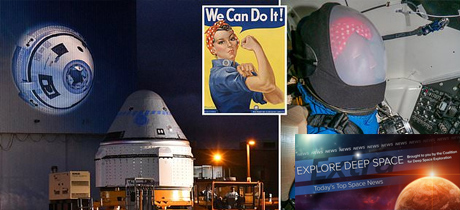In Today’s Deep Space Extra… President Trump signed a budget Continuing Resolution (CR) Thursday preventing a federal government shutdown. The new temporary spending measure is effective through December 20. International Space Station (ISS) astronauts Drew Morgan, of NASA, and Luca Parmitano, of the European Space Agency (ESA), began the second in a series of four spacewalks early Friday to upgrade the external Alpha Magnetic Spectrometer (AMS), a cosmic ray observatory.
2020 Budget
Trump signs short-term spending bill just ahead of shutdown deadline
Washington Post (11/21): President Trump signed a short term budget Continuing Resolution (CR) on Thursday, averting a federal government shutdown. The previous CR went into force on October 1, the start of the 2020 fiscal year, after the House and Senate were unable to complete work on a spending plan for the entire year. The previous CR expired Thursday at midnight. The latest CR permits spending at 2019 levels through December 20. NASA has cautioned that the lack of a formal 2020 budget could adversely impact efforts to accelerate a human return to the surface of the Moon in 2024.
AIA renews call to pass FY 2020 appropriations
Aerospace Industries Association (11/21): AIA president and CEO Eric Fanning urges Congress and the White House to complete work on a budget for 2020, warning that the absence of a budget could lead to a government shutdown after December 20, during the holiday season, causing a hardship, including for those involved in national security activities.
Human Space Exploration
Final spacewalk preps as life science work ramps up
NASA (11/21): NASA astronaut Drew Morgan joined European astronaut Luca Parmitano early Friday for the second in a series of four spacewalks outside the International Space Station (ISS) to overhaul the thermal control system on the Station’s Alpha Magnetic Spectrometer (AMS), a cosmic ray observatory. During the first of the spacewalks, Morgan and Parmitano accessed the inside of the AMS to prepare for the cutting and splicing of liquid carbon dioxide coolant tubes and the installation of a new package of coolant pumps. The observatory was delivered to the Station aboard the shuttle Endeavour in May 2011 and initially intended to last just three years. A multinational team of scientists are hopeful the observatory can unravel the mysteries of dark matter and anti-matter. The planned 6 1/2 hour spacewalk was to get underway at 6:50 a.m., ET. The activities can be followed live at www.nasa.gov/live.
Boeing’s first space-ready Starliner crew capsule meets its Atlas 5 launcher
Coalition Member in the News – Boeing
Spaceflightnow.com (11/21): On Thursday, Boeing’s CST-100 Starliner was successfully mated to its Atlas 5 launch vehicle at the Cape Canaveral Air Force Station, Florida launch site in preparation for a December 17 launch on an uncrewed test flight to the International Space Station (ISS). The mission is a milestone in Boeing’s efforts to achieve NASA Commercial Crew program certification to carry out regularly scheduled launches of astronauts to and from the ISS.
Boeing names space test dummy Rosie after WWII riveter
Coalition Member in the News – Boeing
Associated Press via the New York Times (11/21): Though uncrewed, Boeing’s CST-100 Starliner test launch and mission to the International Space Station (ISS), slated for a December 17 liftoff from the Cape Canaveral Air Force Station in Florida, will have a significant passenger. A test dummy, Rosie the astronaut, is named for Rosie the Riveter in honor of the many women who contributed to a World War II victory by working as tradeswoman in factories across the U.S., in place of the World War II male workforce that had been drafted into the military.
Space Science
NASA’s Curiosity rover finds unexplained oxygen on Mars
Scientific American (11/20): NASA’s Curiosity rover, which has been exploring Gale Crater on Mars since landing in August 2012, has logged some unexpected oxygen readings as it assess the thin Martian atmosphere, which is composed primarily of carbon dioxide. Along with the CO2, oxygen concentrations in the atmosphere rise as temperatures on Mars rise and fall when they cool. The source of the curious activity is a mystery. But the possibilities include biological as well as chemical and geological activity.
Space hardware manufacturers urge realistic expectations for 3-D printing
SpaceNews.com (11/20): Additive manufacturing, or 3-D printing, is an emerging technology that often carries the high expectation. But engineers focused on the topic at the Space Tech Expo Europe in Bremen, Germany this week caution the technology is not as simple as often presumed. The technology has so far proven effective at prototyping components for aerospace, for instance. But it has yet to offer cost savings for serial production, according to an Ariane Group production engineer.
Op Eds
Living off the land: Lunar water is key to crewed space exploration
SpaceNews.com (11/21): As NASA looks to an accelerated return to the surface of the Moon with human explorers in 2024, it’s not alone. The commercial sector is on a mission to participate as well. The cost per kilogram to touchdown on the Moon is a steep $1 million, and an expense that exploration sponsors wish to constrain by working with commercial partners, notes Calhum Heirvu, a mission analyst at Berlin-based Planetary Transportation Systems GmbH. One exploration lure is lunar ice, a potential resource for the production of liquid hydrogen and oxygen rocket fuels and perhaps life support needs such as oxygen to breath and water to drink.
Other News
New details emerge about failed lunar landings
SpaceNews.com (11/21): Problematic thruster performance led to the failed autonomous landing of India’s Chandrayaan 2 Vikram lander and rover on the surface of the Moon’s south pole on September 7 according to an update from Jitendra Singh, minister of state for India’s Department of Space. Vikram hard landed within 500 meters of its target at the lunar south pole. Meanwhile, the Chandrayaan 2 orbiter is successfully returning scientific observations of the lunar surface.

